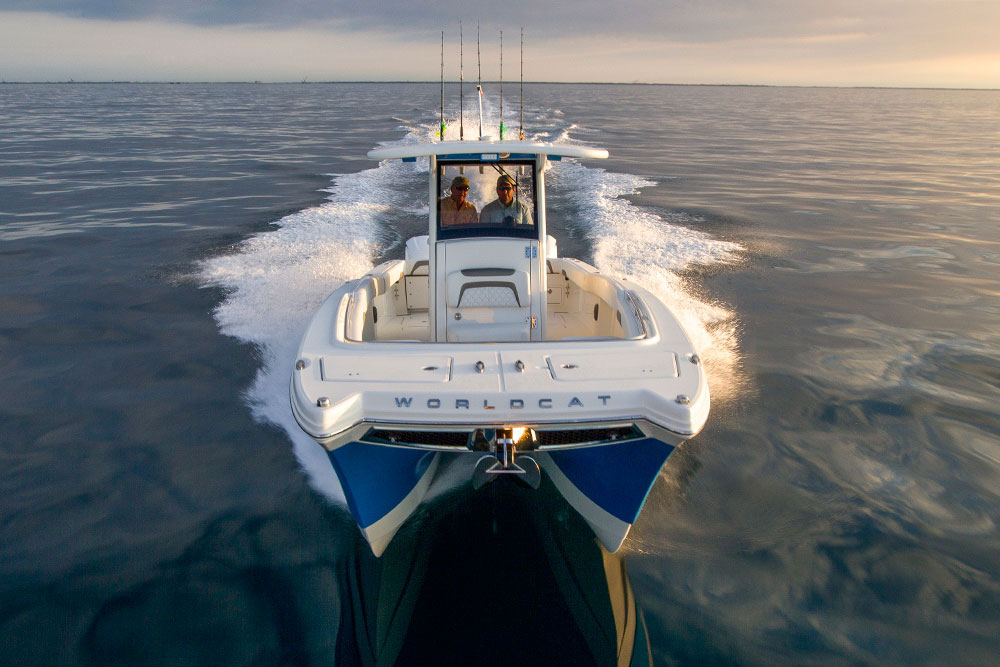by Lenny Rudow
Stand in front of a new World Cat 280 CC-X, and you’ll get an eerily sense of what a skippie must feel like when a big mako circles nearby. The bow of this boat looks rather shark-like, with razor-sharp twin hulls jutting down like jaws, a “grill” reminiscent of a pair of eyes, and a menacing plow anchor nose. It looks like a predator on the attack—which is exactly what you’ll become, when you take the helm and cast off the lines.

Looks, of course, are rather unimportant to a die-hard angler. How a boat performs is far, far more important. And performance is also why more fishermen gravitate towards powercats when compared to other types of boaters. The twin hulls slice open the waves with far less impact than a single, wider hullform (think of two knives going through the water, as compared to a spoon). And as the boat moves forward most cats compresses a cushion of blow-absorbing air between the two hulls. The bottom line? Foot-for-foot powercats tend to run significantly smoother than V-hulls, and as a result, when the wind kicks up you can still go fishing on days when other anglers are sitting at the dock.
Another cat benefit can be found in the bow, which maintains the boat’s full beam all the way forward. You can really see the difference in the 280 CC-X, which has wrap-around seating for six or seven people. Then again, who cares about seating? You and I will pop off those cushions, leave them in the garage, and enjoy an elevated casting deck that’s large enough for at least two anglers. Step down, flip up the hatches, and you have access to a pair of 180-quart stowage compartments with overboard drains (read: fishboxes) and a 36-quart cooler compartment. The bow also houses an anchor locker with a winch, a through-hull anchoring system, and a raw water washdown under the hatch.
Back in the cockpit, you’ll find fishing features like fresh and raw water washdowns, 360-degree coaming bolsters, four flush gunwale and four flush transom rodholders, and a 30-gallon leaning post livewell with a 1,100 GPH pump and a clear lid. I make one beef, here: the five rocket launchers on the hard-top are considered cost-adding optional equipment, when in reality, there isn’t a fisherman alive who wouldn’t want ‘em.
What does come standard is a fixed head in the console compartment, a Fusion Bluetooth stereo system with four JL speakers, and a 12” Garmin GPSMap 7612xsv MFD with a touch-screen. I have nothing against Garmin personally, but note that anglers who prefer a different brand may need to order their boat fresh without it, or rip that puppy out of the dash. Many builders are moving towards standardized electronics systems these days, which is great for installation, but not so great for owner choice.
Another cool feature is the CZone digital switching system. This is a standard, and the 280 CC-X may be the first cat of this size to include it as such. Wait a sec—do you really want to trust all your switches to electrons moving across a strand of copper? Heck yes. People who shy away from digital switching must forget that when you have a switch panel on a saltwater fishboat, after a few years, failure caused by corrosion and age isn’t exactly unheard-of. In the long run, digital switching is actually more reliable.
Speaking of reliable: the standard-issue 280 CC-X is powered by a pair of Yamaha V-6 Offshore F200 outboards. These powerplants provide a cruise at 30 MPH while attaining right around 2.0 MPG. Crank them up, and you’ll come darn close to hitting 50 MPH. That’s even faster than a mako’s maximum speed—which means you just became the apex predator.
World Cat 280 CC-X Specifications:
LOA – 27’6”
Beam – 9’2”
Displacement – 7,300 lbs
Draft (hull) – 1’2”
Transom deadrise – NA (It’s a cat, remember?)
Fuel Capacity – 220 gal
Water capacity – 17 gal.
Max HP – 400